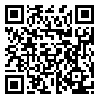1. Otte C, Gold SM, Penninx BW, Pariante CM, Etkin A, Fava M, et al. Major depressive disorder. Nat Rev Dis Primers. 2016;2:16065. [
DOI]
2. Puthran R, Zhang MWB, Tam WW, Ho RC. Prevalence of depression amongst medical students: a meta-analysis. Med Educ. 2016;50(4):456–68. [
DOI]
3. Janbozorgi M, Mostakhdemin Hoseini K. Barrasi shoyou fsordegi dar daneshamoozan madares Tehran [Prevalence of depression in school students in Tehran]. Pejouhandeh. 2005;1 (6):9–15. [Persian]
4. Latkin CA, Curry AD. Stressful neighborhoods and depression: a prospective study of the impact of neighborhood disorder. J Health Soc Behav. 2003;44(1):34–44. [
DOI]
5. Slavin RE. Educational psychology: theory and practice. 8th ed. Boston: Pearson/Allyn & Bacon; 2006.
6. Kesici S, Erdogan A. predicting college students’ mathematics anxiety by motivational beliefs and self-regulated learning strategies. College Student Journal. 2009;43(2):631–42.
7. Smit K, de Brabander CornelisJ, Boekaerts M, Martens RobL. The self-regulation of motivation: Motivational strategies as mediator between motivational beliefs and engagement for learning. International Journal of Educational Research. 2017;82:124–34. [
DOI]
8. Kajbaf MB, Moulavi H, Shirazi Tehrani AR. Study of the relationship between motivational beliefs and self– regulated learning strategies, and academic performance among high school students. Advances in Cognitive Science. 2003;5(1):27–33. [Persian]
9. Parhoon H, Moradi A, Hatami M, Parhoon K. Comparison of the brief behavioral activation treatment and meta-cognitive therapy in the reduction of the symptoms and in the improvement of the quality of life in the major depressed patients. Journal of Research in Psychological Health. 2013;6(4):36–52. [Persian]
10. González-Roz A, Secades-Villa R, Muñiz J. Validity evidence of the Behavioral Activation for Depression Scale-Short Form among depressed smokers. International Journal of Clinical and Health Psychology. 2018;18(2):162–9. [
DOI]
11. Mazzucchelli T, Kane R, Rees C. Behavioral Activation Treatments for Depression in Adults: A Meta-analysis and Review. Clinical Psychology: Science and Practice. 2009;16(4):383–411. [
DOI]
12. Baruch DE, Kanter JW, Bowe WM, Pfennig SL. Improving homework compliance in career counseling with a behavioral activation functional assessment procedure: a pilot study. Cognitive and Behavioral Practice. 2011;18(2):256–66. [
DOI]
13. Kanter JW, Santiago-Rivera AL, Santos MM, Nagy G, López M, Hurtado GD, et al. A randomized hybrid efficacy and effectiveness trial of behavioral activation for Latinos with depression. Behav Ther. 2015;46(2):177–92. [
DOI]
14. Seyedmoharrami I, Pashib M, Tatari M, Mohammadi S. The effect of cognitive-behavioral group therapy on achievement motivation and academic failure students among students of University Of Medical Sciences. J Torbat Heydariyeh Uni Med Sci. 2016;4(1):17–23. [Persian] [
Article]
15. Pasandideh MM, Taheri M. The effectiveness of cognitive-behavioral group therapy on reducing test anxiety and increasing self-efficacy in high school female students. Journal of Clinical Psychology & Personality. 2016;13(2):7–14. [Persian]
16. Besharatloo AL, Shirazad M, Darnavaz M. Asarbakhshi amoozesh shenakhti raftari bar khod karamadi edrak shode va sarzendegi tahsili dar danesh amoozan paye 6 ebtedai [The effectiveness of cognitive-behavioral education on perceived self-efficacy and academic vitality in sixth grade elementary students]. Studies in Psychology and Educational Sciences. 2017;3(4):76–87. [Persian] [
Article]
17. Shakibaei F, Esmaeili M. Study of MDD epidemiology in students of middle school (11-16 yrs. old) Of Esfahan city in 2007–8. Journal of Research in Behavioural Sciences. 2014;12(2):274–84. [Persian] [
Article]
18. Gall MD, Borg WR, Gall JP. Educational Research: An Introduction. Longman; 1996.
19. First MB, Spitzer RL, Gibbon M, Williams JBW. Structured Clinical Interview for DSM-IV Axis I Disorders (SCID-I), Clinician Version: Administration Booklet. American Psychiatric Association Publishing; 1996.
20. Sharifi V, Assadi SM, Mohammadi MR, Amini H, Kaviani H, Semnani Y, et al. A Persian translation of the Structured Clinical Interview for Diagnostic and Statistical Manual of Mental Disorders, Fourth Edition: psychometric properties. Compr Psychiatry. 2009;50(1):86–91. [
DOI]
21. Beck AT, Steer RA, Brown GK. BDI-II, Beck Depression Inventory: Manual. 2nd ed. San Antonio, Tex : Psychological Corp ; 1996.
22. Gharayebi B. Determining the status of identity and its relationship with identity styles and depression in adolescents [PhD dissertation]. [Tehran, Iran]: Iran University of Medical Sciences; 2004. [Persian]
23. Pintrich PR, Smith DAF, Garcia T, Mckeachie WJ. Reliability and Predictive Validity of the Motivated Strategies for Learning Questionnaire (MSLQ). Educational and Psychological Measurement. 1993;53(3):801–13. 10.1177/0013164493053003024
24. Sohrabi N, Shehni Yailagh M, Haghighi J, Mehrabizadeh Honarmand M. The study of cognitive, motivational and personality variables as predictors of giftedness in shahid chamran university students. Journal of Education and Psychology. 2010;4(2):1–36. [Persian]
25. Martell CR, Addis ME, Jacobson NS. Depression in Context: Strategies for Guided Action. Norton; 2001.
26. Leahy RL, Holland SJF, McGinn LK. Treatment Plans and Interventions for Depression and Anxiety Disorders.New York: Guilford Press; 2012.
27. Shareh H. Effectiveness of behavioral activation group therapy on attributional styles, depression, and quality of life in women with breast cancer. Journal of Fundamentals of Mental Health. 2016;18(4):179–88. [Persian] [
DOI]
28. Ghadimpoor E, Sabzian S, Beyranvand S. The Effectiveness of cognitive-behavioral Education on test anxiety in high school girl students of Isfahan city. Journal of Cognetive Strategies in Learning. 2014;1(1):49–60. [Persian] [
Article]
29. Ghamari Givi H, Alizadeh R, Mojarrad A. The effect of cognitive-behavioral and existential methods on reducing test anxiety in nursing students. Iranian Journal of Medical Education. 2018;18:282–91. [Persian] [
Article]
30. Werner KH, Goldin PR, Ball TM, Heimberg RG, Gross JJ. Assessing emotion regulation in social anxiety disorder: The emotion regulation interview. J Psychopathol Behav Assess. 2011;33(3):346–54. [
DOI]
31. Hazlett-Stevens H. Psychological Approaches to Generalized Anxiety Disorder: A Clinician’s Guide to Assessment and Treatment. Springer Science & Business Media; 2008.






